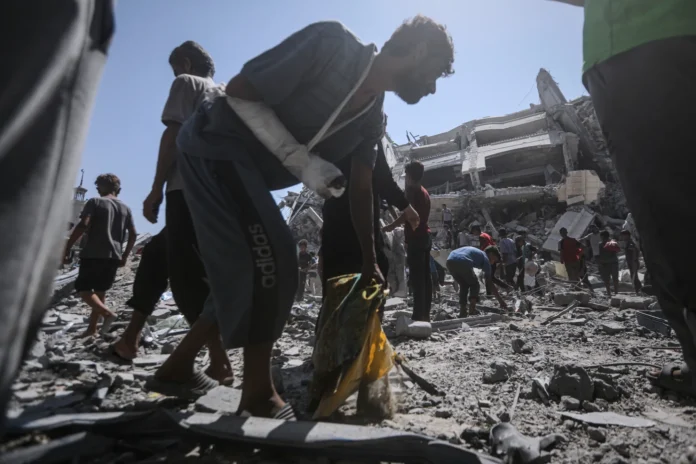Escalation in Gaza City
Israel’s military campaign in Gaza City entered a new and more aggressive phase on Friday after fighter jets struck and demolished the Mushtaha Tower, a prominent 12-story residential building located in the Rimal neighborhood. The strike, carried out minutes after evacuation warnings were issued, symbolized what Israeli Defense Minister Israel Katz described as “opening the gates of hell” against Hamas.
The Mushtaha Tower, once home to hundreds of families, crumbled into a vast plume of smoke and debris, an image that quickly spread across international media. Israel claims the building served as a hub for Hamas activity, though local residents and building management deny this, insisting it was primarily sheltering displaced civilians.
The attack underscores Israel’s determination to seize full control of Gaza City, a densely populated area housing nearly one million Palestinians. It also highlights the intensification of “Operation Gideon’s Chariots II,” launched earlier this month with the stated aim of dismantling Hamas’s last major stronghold.
Military Strategy and Operational Gains
Brigadier General Effie Defrin, spokesperson for the Israeli Defense Forces (IDF), announced Thursday that troops had secured “operational control” over 40% of Gaza City. He emphasized that the military will “deepen operations” in the coming days, focusing particularly on high-rise structures alleged to conceal Hamas fighters and command centers.
Israel has mobilized approximately 60,000 reservists for the operation, marking one of the largest deployments since the conflict erupted. Defense Minister Katz declared that Friday’s strike was only the beginning, warning that “when the door opens it will not close.” Israeli officials maintain that more targeted strikes will follow, aiming to neutralize what they describe as “terrorist infrastructure” embedded within civilian neighborhoods.
The destruction of Mushtaha Tower reflects Israel’s strategy of targeting symbolic and strategic sites to weaken Hamas’s grip over Gaza’s urban core. However, critics warn that the strategy risks deepening humanitarian suffering and further eroding chances for ceasefire negotiations.
Humanitarian Toll and Civilian Casualties
According to Gaza’s health ministry, at least 69 Palestinians were killed and 422 injured in the past 24 hours alone, with 30 deaths reported in Gaza City. The victims include six individuals who were struck while seeking humanitarian aid. Many of the casualties occurred near temporary tent encampments surrounding Mushtaha Tower, where displaced families had gathered in search of shelter.
Eyewitnesses described chaotic scenes in the moments before the strike. Local resident Ahmed al-Boari recounted watching families throw belongings from upper floors as they scrambled to escape. Humanitarian groups argue that even with evacuation warnings, residents had little time to flee in such a densely populated environment.
The United Nations and multiple aid organizations issued urgent statements warning of catastrophic consequences if Israeli forces expand their offensive deeper into Gaza City. With famine already declared last month and essential supplies scarce, the ongoing escalation threatens to exacerbate an already dire humanitarian crisis.
International Reaction

International response has been swift and divided. Western governments have expressed support for Israel’s right to self-defense but urged restraint to minimize civilian casualties. Meanwhile, Arab and Muslim-majority nations condemned the strike, calling it a blatant violation of international humanitarian law.
The UN’s humanitarian coordinator described the assault as “a devastating blow to civilians already enduring famine-like conditions,” while Amnesty International reiterated calls for an immediate ceasefire. Diplomatic efforts, however, remain stalled, with no visible progress toward renewed negotiations.
Hamas Response and Hostage Concerns
Amid the escalation, Hamas released a video on Friday featuring two Israeli hostages, Guy Gilboa-Dalal and Alon Ohel, both kidnapped during the October 7, 2023, music festival attack. In the footage, Gilboa-Dalal pleads for his life, claiming to be held somewhere inside Gaza City as the Israeli offensive intensifies.
The release of the video has reignited fears for the estimated 48 hostages still in Hamas captivity. Israeli authorities believe only around 20 remain alive. Families of the hostages and protesters within Israel have criticized the Gaza City offensive, arguing that it endangers the captives’ lives and urging the government to prioritize negotiations over military action.
Talks for a ceasefire collapsed in July after both sides failed to compromise on core demands. Israel insists on Hamas’s full disarmament and unconditional release of hostages, while Hamas seeks a lasting ceasefire and a complete Israeli withdrawal.
A Conflict at a Critical Juncture
Friday’s strike on Mushtaha Tower marks a turning point in the conflict, demonstrating Israel’s readiness to escalate operations regardless of mounting international concern. As Israeli forces push further into Gaza City, both the humanitarian toll and the risks to remaining hostages grow increasingly severe.
With diplomacy stalled and violence intensifying, Gaza’s civilians remain caught in the crossfire, facing an uncertain future under siege conditions. Whether this latest offensive will weaken Hamas or further entrench the cycle of violence remains a pressing question for regional stability.
Sources: BBC


